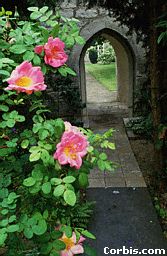 |
| Rake Out Poison Ivy If you're overrun with poison ivy, rake it out. Use a sturdy rake and carefully tug at the ivy. Most of it will come right up, roots and all. When you're done, rinse off the rake to get rid of any plant oils. Wash your hands well, too, if they came in contact with the ivy or the bottom of the rake. Boil Away Ivy Small patches of poison ivy can be safely eradicated from your yard by dousing them with boiling water. Killing Unwanted Grass and Weeds You can also kill grass or weeds growing between sections of cement walk with salted boiling water. |
| Spacing Your Ground Covers Because ground covers cost more initially than lawn seed, some gardeners try to economize by setting the plants a good distance apart. You'll use fewer plants this way, but you'll have to battle weeds until the plants establish themselves. The ideal method is to set small plants close together. Planting on Banks or Slopes When planting on a bank or slope, cut pockets into the bank at different heights along its lenght and wedge stones deeply into the holes. Then cover with a good rich soil and plant the ground cover. The stones help anchor the young plants' roots, keeping them from being washed away during rains. Off to a Good Start Water your ground cover occasionally during the first season. Top-dress it with compost, humus, or well-rotted manure to supply the nitrogen needed for the dense growth that will cover the ground without any "holes". As the plants grow, they will strangle any crabgrass or plantain. Once established, ground covers need no special care. Keep off the Ground Cover No ground cover can cover the soil as closely as a good grass turf. Ground covers are therefore not recommended for any area where there is traffic--none of them will stand up to wear. Walks should be built through areas covered by plants other than grass, because almost any ground cover will succumb to trampling. Ground Cover under Shade Trees Dense shade trees cut out enough sunlight that grass has a difficult time growing under them. One solution is to keep trimming off lower branches as the trees grow taller, so that sunlight can angle to the ground under the branches. An alternative is to grow a shade-loving ground cover, such as ivy or pachysandra, under these trees instead of grass. |
| (Source: Rodale's Book of Hints, Tips & Everyday Wisdom) |
| # Pests and Other Wildlife # |
| Ammonia Keeps Dogs Away Discourage dogs from ripping apart your plastic trash bags when they're put out for pickup by sprinkling them with ammonia. The fumes will keep the dogs away. Hot Spray Deters Cats and Dogs To keep cats and dogs off your lawn, put two or three cloves of garlic and three or flour hot red peppers into a blender and grind them up. Then combine the mixture with a bucketful of water and add a few drops of dishwashing liquid. Mix well. Sprinkle the solution around the edges of your yard and garden and along sidewalks. Repeat often, especially after a rain. Pepper Your Flowers To keep cats and dogs out of your flower beds, sprinkle the beds liberally with black pepper. The animals dislike the smell, and if they get too close, they'll have sneezing fits. Basil Repels Flies To keep flies away from outdoor dining areas, grow a pot ot two of basil. Put the potted plants on the table. When you sit down to eat, pinch some leaves off and crush them in your hand. The released oils will repel the flies. Repeat as needed. Slugs Slugs will avoid a garden ringed with a light sprinkling of moth crystals (not mothballs). This is also discourages cats, dogs, and raccoons. Feed the Birds - Save your old net onoin bags and use them as "hanging baskets" for suet. The holes in the bags allow the birds easy access to the suet. - Feed wild birds sunflower seeds right off the flower head. Just slip the entire sunflower head into a rope plant hanger usually used to suspend plastic or ceramic pots and tie it on a tree limb. The birds love it. - You can make your own bird seed. Save the pulp and seeds from squash and other vegetables and spread it thinly on a plate or tray. Then leave the tray in a gas oven overnight. The pilot light generates just enough heat to dry the pulp and make it easy to pick out the seeds. If you have a pilotless gas oven or an electric one, you can dry the seeds by setting the oven at its lowest temperature and heating them for several hours. - Instead of lugging out heavy bags of bird seed to your feeders, use an ordinary watering can to carry the seed. It holds enough to fill several feeders in one trip, and the spout directs the seed so that it isn't spilled. If your bird feed contains especially large seeds, this may not work because they'll clog the spout. - Store bird seed in trash can with a tight-fitting lid. Have the can filled before winter arrives, and locate it near your bird feeders so that you don't have to carry scoops of seed far in bad weather. |